Continuing on the theme of discussing Magic tactics, I want to expand on the idea of controlling the flow of the game. A crucial aspect to this is hidden information—using not only your cards, but the threat of your cards. Hidden information is the element that makes Magic such a deep, tactical game. The fact that your opponent doesn’t know what you have can be exploited to your advantage, and it’s a major reason that the information from cards like Duress, Gitaxian Probe, and Vendilion Clique is often as valuable—or in some cases, more valuable than whatever other effect the card provides.
Controlling and using the threat of various cards is a huge part of understanding how the game of Magic operates on a fundamental level, and it’s a powerful tool that can be used to great advantage in a wide variety of situations. Sweepers are among the most crucial aspects to understanding how hidden information interacts with the game specifically, so I’m going to talk about those first.
Here is the important thing to know about sweepers: When you deal with sweepers, it’s not about cards, it’s about time.
When most people look at a card like Wrath of God, they see a source of card advantage. While this is true, it is not the proper way to look at the card. The strength of Wrath of God and all sweepers lies not in their ability to generate card advantage, but in their ability to control the development and flow of the game. In other words, sweepers’ primary strength is their ability to control both the timing and quantity of threats that hit the table. The proper question to ask when dealing with sweepers always centers on this crucial concept: How much time am I gaining or losing?
Let’s look at sweepers in more detail. There are three basic types of sweepers: incomplete sweepers, basic sweepers, and sweepers with benefits. Each of these has a distinctly different impact on the game and needs to be used differently—both in an actual sense and in their impact as threats.
The Basic Sweeper
Basic sweepers are sweepers that have very few frills attached. In general, they are designed to kill a large number of creatures and do so with almost guaranteed consistency. The baseline for this group of sweepers is, of course, Wrath of God, but there are others as well. Let’s take a look at some of the basic sweepers that have appeared throughout Magic’s history.
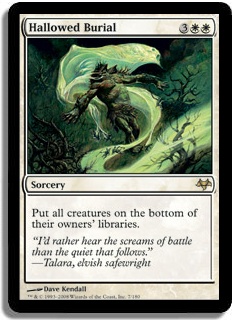 |
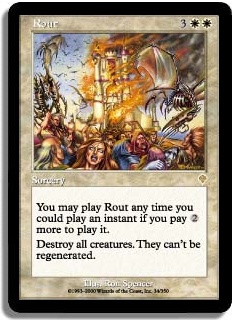 |
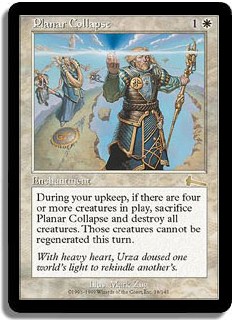 |
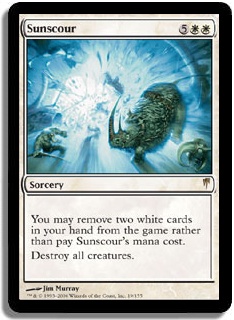 |
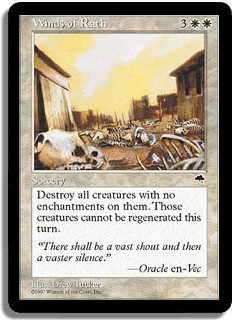 |
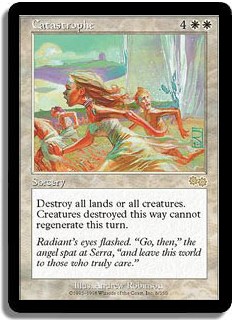 |
Obviously, this is not an exhaustive list of all the basic sweepers that have ever been printed in Magic’s history. I chose these cards as a sampling of the potential variety you can find even within this relatively restrictive category. All of these cards qualify as basic sweepers of some sort. They range from potentially free (Sunscour) to the relatively expensive 6 or 7 mana you could pay up front for Catastrophe or Sunscour. Winds of Rath has a condition that you can take advantage of, Planar Collapse has a trigger condition, and Catastrophe has an alternative use.
I talked for a while about Wrath of God and thus by extension, basic sweepers, quite a bit in my article two weeks ago. Let’s expand on the contents of that article and talk a little bit about the various factors that influence basic sweepers.
The biggest thing to understand here is that sweepers control the game through timing. The threat of a sweeper controls your opponent’s ability to commit resources to the board. If your opponent commits too many resources, the sweeper will have the ability to remove all of those creatures and put your opponent in a position where he has no pressure on the table and is incapable of pressuring you in the future. This will result in a lost position.
This is the greatest strength of the basic sweeper and the primary thing that you should be using when you are playing it. There is a line your opponent cannot cross if you are playing with effective basic sweepers, and if your opponent crosses it, you need to be ready to punish him by casting the sweeper. This is why it’s so important to run three to four copies of most sweepers—so that you see them consistently. Having the sweeper to follow up the threat of a sweeper is a huge part of playing sweepers. You won’t always have it, but you’ll have it enough of the time that your opponent cannot afford to take a chance on it not being in your hand.
This is why the sweet spot for this category of sweepers is 4 mana in Constructed (it varies in Limited formats). The way the natural development and power-to-mana-cost curves for creatures works results in a situation in which 4 mana is the defensive turning point. Why? The answer is simple. By turn four, you can be under significant pressure of dying either immediately or on the next turn, but you have also given your opponent the opportunity to overcommit.
The basic idea behind this point is that it is the point at which the game has had the ability to reach three separate conditions with no action from you.
- You are either dead on the board or effectively dead on the board.
- You are in a survivable position if all your opponent’s creatures die now.
- Your opponent has deployed sufficient resources that a sweeper will be very damaging to his chances of mustering a future assault.
Turn four is the turn when these three things end up being true the most often. By turn five, you are more likely than not either dead or effectively dead on the board. Any earlier, and it’s likely that your opponent hasn’t committed enough resources for your sweeper to be incredibly damaging (especially if he was on the draw).
Consider the fundamental Sligh curve, which hasn’t really changed at all:
1-mana creatures: 9 to 13
2-mana creatures: 6 to 8
3-mana creatures: 3 to 5
4-mana creatures: 1 to 3
X spells: 2 to 3
Lightning Bolts (critter-kills): 8 to 10
Mana: 23 to 26, 15 to 17 colored
The basic design of this curve serves to maximize mana usage each and every turn. You’ll see a similar principle behind Zvi’s two most famous decks: My Fires and Mythic. The development of these decks is based on curve considerations and dictates that they are likely to threaten lethal damage on or about turn four. The development looks something like this:
T1:Birds of Paradise or Stromkirk Noble
T2: Lotus Cobra, Knight of the Reliquary, or Stormblood Berserker
T3: Sovereigns of Lost Alara (you won’t be dead, but you’ll be very close) or Chandra's Phoenix
T4: Kill you
The point is that on turn four, assuming you are doing nothing, you can be threatened with a position in which you are dead.
The combination of being able to relieve pressure while hindering your opponent’s future development is very important. The power of the sweeper lies in the ability to relieve a large amount of pressure from multiple sources. This is why Wrath of God is significantly more powerful than the equally common Path to Exile or Swords to Plowshares. This is not saying that one card is better than the other—just that they serve different functions. Because sweepers possess this power, the use of sweepers relies heavily on this threat. By showing the ability to cast a basic sweeper, the primary thing you are attempting to control is your opponent’s ability to put additional threats on the table.
This is why it’s important to take your opponent into consideration both when playing with and against sweepers. The more conservative your opponent, the less likely he is to commit additional resources to the board and thus be blown out by a sweeper. You can use this to your advantage because it allows you to use your other resources more effectively. A more aggressive opponent will be more willing to lose to the sweeper, and thus will more frequently put threats on the table. This is something you have to take into account when planning your other spells. I’ll talk about this more in detail later.
The Incomplete Sweeper
Incomplete sweepers are sweepers that are either incapable of killing all creatures on the table or will sometimes leave relevant threats behind despite sweeping the rest of the table. Most frequently, these sweepers are Red or Black, but that isn’t always the case. Let’s take a look at some examples.
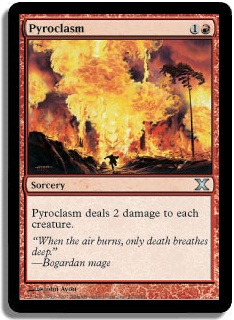 |
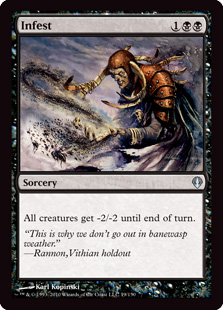 |
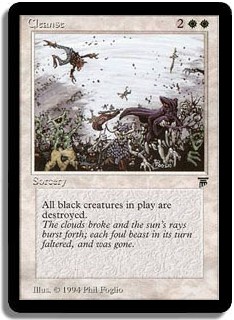 |
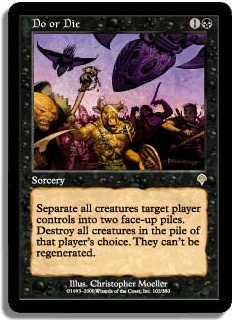 |
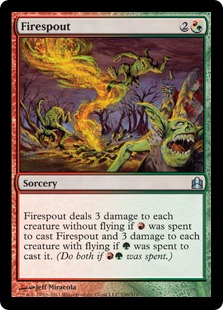 |
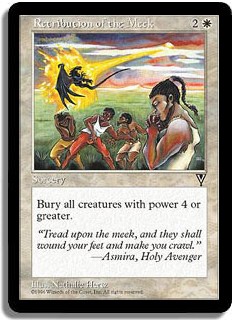 |
Incomplete sweepers typically have some limitation associated with them. Most commonly, it is the toughness of the creatures it is trying to sweep. Most incomplete sweepers sweep by means of damage or giving things -X/-X, which is limiting against large creatures or creatures with high toughness. However, it is important to note that incomplete sweepers are often cheaper than basic sweepers for this very reason—they don’t always get everything.
So, how does this factor in when playing incomplete sweepers?
There are effectively three possible situations for you to be in with your incomplete sweeper.
- Your incomplete sweeper is functionally a basic sweeper—your opponent has no threats that survive it.
- Your incomplete sweeper is effective, but your opponent has a solid number of threats it will not deal with.
- Your incomplete sweeper is ineffective.
In Situation 1, you are golden, and you can just play this kind of sweeper as you would a full sweeper, only it’s cheaper, so you are in an awesome position. In Situation 3, you should do whatever you can to get value out of the card, and remove it from your deck when you sideboard. These two situations are relatively simple. Situation 2 is slightly more complicated.
In Situation 2, the game revolves around the threats your opponent has that survive your sweeper. The basic give and take that occurs is where your opponent will attempt to under-deploy his threats that die to the sweeper and over-deploy the ones that don’t. By doing so, he will be able to maintain pressure while not losing tempo or card advantage when you play your sweeper. Your job is to counter this idea by focusing your attention on neutralizing his larger threats (the ones that survive your sweeper).
A good example of this principle is Firespout against Zoo decks that play Tarmogoyf and Knight of the Reliquary. Depending on the variant of Zoo, threats like Wild Nacatl, Steppe Lynx, Goblin Guide, Qasali Pridemage, Dark Confidant, and Kird Ape will also be present. Firespout is effective against all of these cards, however Tarmogoyf and Knight of the Reliquary are likely to survive the 3-mana sweeper. In addition, those creatures are sufficiently large to place significant pressure on an opponent who has just swept the board. ’Goyf is frequently a 3/4 or a 4/5, and the Knight often becomes much larger than that.
Consider that a Zoo player who deploys a Wild Nacatl and a Tarmogoyf can easily have 6 or 7 power on the board very quickly, thus removing the need to deploy further threats. A combination like Knight of the Reliquary and Qasali Pridemage has a similar effect. Here, the Zoo player can successfully maintain a large board presence while remaining under-deployed against Firespout—he only has one threat that dies to it.
Knight of the Reliquary and Tarmogoyf are the two cards that are enabling the Zoo player to do this. The fact that they survive Firespout is crucial. Thus, when playing the Firespout, it is crucial to target Knight of the Reliquary and Tarmogoyf and keep them off the table, thus forcing the Zoo player to play into the sweeper to maintain solid pressure against your position. This is why it’s important, whenever possible, to save your Swords to Plowshares and Path to Exiles for Tarmogoyfs and Knight of the Reliquary.
The Sweeper-Plus
Sweepers that come with benefits are what I call sweepers-plus. Let’s take a look at some examples:
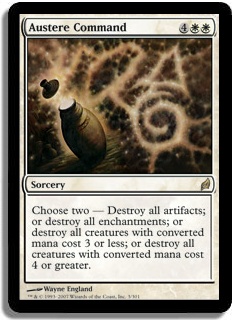 |
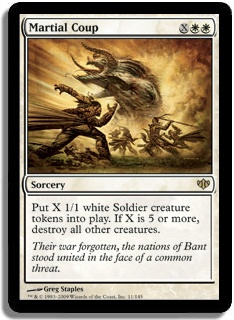 |
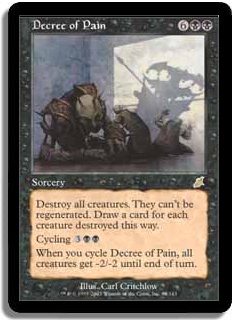 |
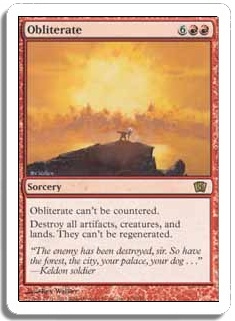 |
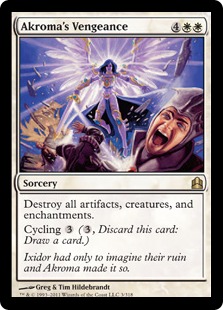 |
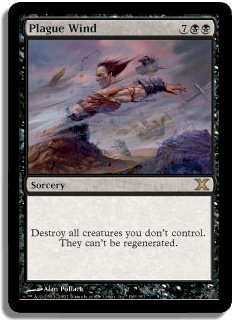 |
As you can see, sweepers can come with a variety of benefits attached. These range from the ability to destroy noncreature permanents to perks such as uncounterability, extra cards, or leaving your own creatures behind. So, what are the differences between these types of sweepers and the basic sweepers that just wipe everything off the table?
Sweepers like this are all about maximizing the advantages that they give you outside of killing all the creatures on the table. Basically, there are two types of sweeper-plus: sweepers that leave you the ability to apply pressure and sweepers that provide you more card advantage in a different way.
With card-advantage sweepers, it is important to maximize the amount of time you buy when you play the sweeper. This means using it as late as possible and grabbing the largest percentage of your opponent’s resources as you believe is reasonable. These types of sweepers are often best used as a second sweeper to clean up your opponent’s reload from the first sweeper. This is because sweepers like this require time for their full effect to be seen. Card advantage in and of itself doesn’t win you the game. You can draw twice as many cards as your opponent and still lose because you either didn’t have time to deploy all your cards or because you drew ineffective cards.
You can take care of one of these two possibilities: the time. The sweeper will by you at least a turn, and your job is to extend that window as long as possible. During this time, the extra card advantage that comes from your sweeper will give you the ability to snowball your advantage into a very strong position.
The other kind of sweeper is the kind that leaves pressure around for you. This sort of sweeper is highly effective because of its predictability. Generally, these are used in two separate ways: to stabilize the board and to finish off the opponent. The latter of these is fairly obvious. If you use this kind of sweeper to kill the last group of creatures your opponent has, the threat or threats it leaves behind will be able to finish the game for you.
These kinds of sweepers are also excellent at stabilizing the board. The threats they leave behind enable you to deal with subsequent aggression from your opponent, thus these types of sweepers-plus are very, very good at buying you large amounts of time to develop your board position and draw more cards.
Supporting Your Sweepers
Sweepers are the foundation of many attempts to control hidden information and game flow. However, they can’t accomplish their task alone. It is absolutely critical to support sweepers by positioning other spells (most often counterspells and removal) correctly. Spell placement and spell selection has to complement the goals of the sweeper and thus ensure that your cards work in concert with each other, making them more powerful than the sum of their parts.
Remember that the goal of a sweeper is to do the following two things:
- Buy time to develop your position
- Relieve large amounts of pressure from the table, allowing you to develop your board position and game plan
Because of this, it is important to make sure that your spell sequencing outside your sweeper is designed to complement this goal. There is no need to use the sweeper when you can buy a similar amount of time using a single removal spell—this is a more efficient use of your resources. If you use the sweeper, you will be unable to threaten the same sweeper against your opponent for his second wave of attackers, and thus you will be under more pressure. However, if you buy the time with the removal spell first, you can use that time, then buy more time by using your sweeper on the second wave of attackers. This sort of spell sequencing is key to understanding how to control game flow and take advantage of hidden information.
(I will cover this in more detail in my next article, but the basic principle is to use your non-sweeper cards to buy more time to develop your position. Counterspells and removal (the two most common types of support spells) can be used in a variety of ways, but the primary goal should always be to buy more time to support the sweeper.)
Card-draw spells are similar because they should be played whenever you have the opportunity to do so. Whenever you are successfully able to purchase a reprieve from your opponent, your goal should be to accomplish one of the following: generate card advantage or attempt to transition to an offensive stance.
Generating card advantage is the method by which you will be able to defend yourself against subsequent aggression by your opponent. If you defend yourself well, you will put yourself in an even more advantageous position. Keep doing this, and you will eventually have an easy time transitioning into killing off your opponent. Defend well enough, and it doesn’t matter what your win condition is.
The archetypical example of this is Forbidian:
"Forbidian, by Jon Finkel"
- Creatures (12)
- 1 Silver Wyvern
- 3 Tradewind Rider
- 4 Man-o'-War
- 4 Ophidian
- Spells (27)
- 2 Capsize
- 2 Mana Leak
- 3 Forbid
- 4 Counterspell
- 4 Impulse
- 4 Whispers of the Muse
- 4 Legacy's Allure
- 4 Sapphire Medallion
- Sideobard (15)
- 1 Disrupt
- 4 Hydroblast
- 2 Meekstone
- 2 Null Rod
- 3 Phyrexian Furnace
- 3 Suq'Ata Firewalker
There is only one card in this deck with an offensive function: Silver Wyvern. Everything else has a defensive function. You could even remove the Silver Wyvern, and the deck would still function fine—the deck doesn’t need Silver Wyvern. You can win the game with random Man-o'-War, Tradewind Rider, and Ophidian beats after you have bounced all the opponent’s permanents with Tradewind Rider and Capsize. Forbid prevents the opponent from resolving any spells during this process, and eventually, he will not have the ability to cast spells. Thus, it doesn’t matter how you win the game, just that you can.
Forbidian is a deck that defends until it is impossible for the opponent to win the game. At that point, it doesn’t really matter how the Forbidian player actually plans to win the game—the game is already over. The other player has already lost.
Most decks are incapable of defending this well; however, the basic principle is still the same. Defend until the opportune moment to transition to an offensive stance using the time you bought defending. If you can use that time to deploy threats that are more powerful than your opponent’s, you will have shifted the paradigm to favor you. You will put your opponent into a position in which he is forced to defend against powerful threats from you—something proactive decks are generally ill-equipped to do. By shifting the focus of the game from something his deck is good at (being proactive and executing a strategy) to something his deck is bad at (being reactive and defending against a strategy), you automatically gain an intangible advantage that you can press. If his defense is inadequate, you will simply kill him off.
All in all, sweepers are a very powerful element for controlling the flow of the game, and I hope you’ve been able to learn from this article some basic principles and ideas on how to take advantage sweepers. It’s not just about casting the sweeper and profiting, but about how you use the threat of the sweeper to control your opponent’s development. This is a very popular misconception when people play sweepers—it’s not about cards, it’s about time.
Chingsung Chang
Conelead most everywhere and on MTGO
Khan32k5 at gmail dot com





















